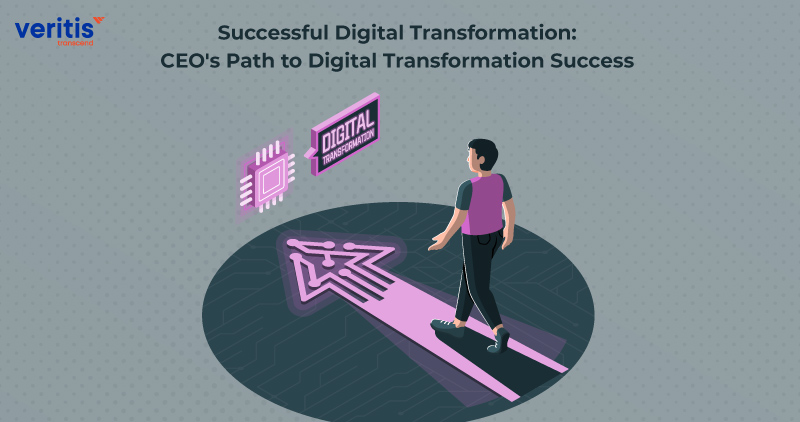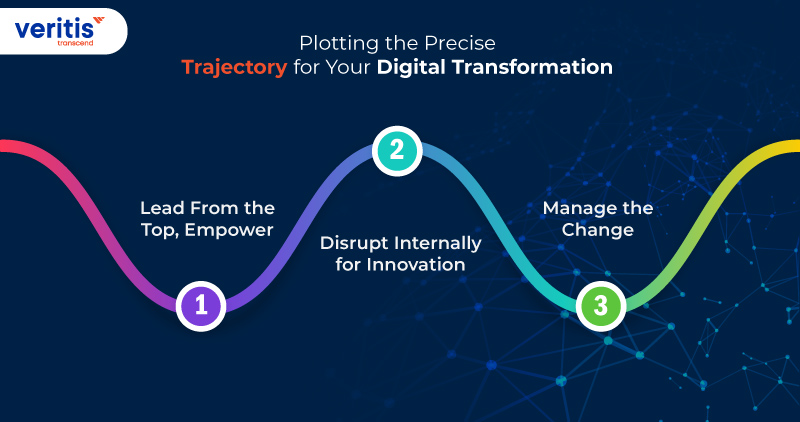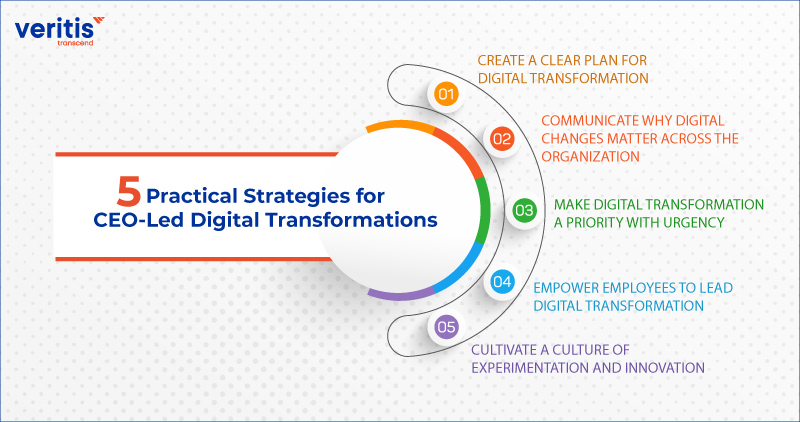
Embracing digital transformation is not a choice anymore; it has become an imperative. Businesses must undergo digitalization, and their leaders must spearhead this effort to stay competitive and relevant.
CEOs hold a pivotal position in propelling digital transformation endeavors within their companies. However, cultivating an environment conducive to change can pose considerable challenges. The digital age can create obstacles for CEOs as they strive to stay updated on the latest advancements and determine the optimal path for their organization.
The responsibility of driving digital transformation falls squarely on the shoulders of the CEO. Only the CEO possesses the authority to initiate the profound changes necessary for a successful transformation. This is because reinventing a business model requires different departments to collaborate innovatively. And this can be achieved through substantial investments and comprehensive changes that originate from the highest levels of leadership.
Purpose-driven leadership is indispensable in steering and shaping a successful digital transformation. The leadership methods employed by CEOs are of paramount importance, not only due to their ability to establish a course but also because they shape the collaborative dynamics of their teams, ultimately leading to more substantial outcomes.
Organizational preparedness and a CEO’s vision can lay the foundation for success. From our perspective, leadership within digital transformation emerges as the most pivotal factor in ensuring a transformation’s success.
What is Digital Transformation?

Getting digital transformation right can bring incredible returns on investment, but how do you make sure your organization falls into that successful 30%? This is a challenging question, and there’s no one-size-fits-all answer.
To understand the full scope of digital transformation, let’s take a quick look back. The term “digital transformation” has existed in the business world since the late 1990s. Initially, it was pretty literal—organizations shifted from old systems to digital ones or replaced paper-based processes with digital alternatives. For instance, in 2001, it might have meant converting a paper ledger into a digital spreadsheet.
Organizations moved towards more comprehensive digitalization from the early 2000s to the 2010s. They aimed to eliminate manual work in entire departments or functions, replacing spreadsheets and databases with cohesive digital workflows. They pursued operational efficiency, cost savings, and improved customer experiences through these transformations.
The global pandemic had a more significant impact on the digital transformation plan. In a remote work-focused world, many organizations stuck with the status quo struggled in a disrupted landscape. The pandemic accelerated the implementation of digital transformation technologies by several years and changed how and where we work. Even as more people return to the office, 73% of workers expect to have flexible remote options.
In 2023, supply chains are still recovering, organizations compete fiercely for top talent, and consumer expectations are more digital-focused than ever.
Digital transformation is a broad concept that has evolved over many years. Its interpretation varies, and the first challenge in any digital transformation project is defining what it means for your organization. You need to narrow your focus and understand what needs to be done and why. Your criteria for measuring success should align with that definition as well.
Determining the Scope of Digital Transformation
Digital transformation has evolved beyond mere buzzwords. The digital era is here to stay, and businesses must change, or they might fall behind. Different organizations have different aims for digital transformation. Some leaders want to use new tools to make work easier, while others want to move their operations to the cloud or use artificial intelligence.
However, a CEO’s goal for data driven digital transformation should be using something other than new tools because they’re available. It should be about how these changes can make the whole organization better.
For instance, if you want to make your company work more efficiently by automating tasks and reducing mistakes, your goal should be to use automation to reduce errors, not just use AI or another tech without a clear plan.
The goal should be based on what will help your business save money or boost productivity, not just using new tech because it’s there. Leaders should guide their organization’s digital transformation strategy by setting digital transformation goals that match the company’s goals. This way, everyone works toward the same thing and uses technology in the best way possible.
Useful Link: Digital Transformation: Avoid 8 Most Common Pitfalls
The Step-by-Step Progress Towards Digitalization
Businesses that don’t adapt to digital changes risk falling behind. But even though CEOs know they need to use digital technology, they often need to learn how to start. The first step is not rushing into things. It’s essential to take the time to figure out how much digital change is right for your business. If you feel overwhelmed or don’t know where to begin, consider starting from scratch with your digital processes.
Slowly moving toward using digital tools can set the stage for success in the future. If your business is thinking about going digital, gradually use technology, even if it doesn’t make a big difference initially.
These steps might take time to change your business, but they can make future digital changes happen faster. CEOs usually start these significant changes, but the whole team needs to be involved to make them work. As a leader, your job is to support the process and remove obstacles rather than doing all the work yourself.
Plotting the Precise Trajectory for Your Digital Transformation

While there’s no one-size-fits-all approach to digital transformation solutions, you can tailor a path that suits your organization’s unique requirements. At Veritis, we’re experiencing rapid growth, and to succeed in a changing world, I’m leading our evolution and transformation.
The real work begins once you’ve figured out how and why you need data driven digital transformation. Three key things are essential for a successful digital transformation plan.
1) Lead From the Top, Empower
Everyone’s Digital transformation should be central to a modern CEO’s vision. Once you’ve customized digital transformation solutions to fit your organization, integrate this concept into your digital transformation strategy, goal-setting, and decision-making processes. Ensure everyone in your organization, from the top executives to individual contributors, is on board.
To drive digital transformation successfully, empower leaders at all levels to carry out transformation projects. Don’t let every decision be made by consensus, or you risk slowing down initiatives, regardless of their size.
2) Disrupt Internally for Innovation
Instead of constantly trying to catch up with external changes, focus on disrupting from within. According to McKinsey, 64% of business leaders believe building new digital ventures is vital for economic viability.
Disruption paves the way for innovation and the establishment of crucial new digital enterprise digital transformation. Internal disruption can be challenging and uncomfortable, but breaking old patterns and becoming more robust is necessary. If you’re not bold enough to do it, your industry peers will.
Make digital transformation an ongoing practice to ensure you have the flexibility to drive internal disruptions when needed.
3) Manage the Change
Change can be challenging, especially for well-established organizations that used to do things a certain way for a long time. It’s challenging to shift gears when you’ve followed the same practices for decades, and the technical hurdles can be daunting.
Even organizations born in the digital age can struggle with change. Change management is a crucial but often overlooked aspect of digital transformation. While technology is vital, the people using these digital transformation technologies genuinely determine the success of digital transformation.
Keep your employees informed and involved to inspire their support for the CEO’s vision. Understand that not everyone may embrace this vision, especially those who’ve been doing the same job the same way for a long time. Part of managing change is supporting a workforce in transition.
Useful Link: Digital Transformation Journey: 3 Hurdles to Learn From!
Five Practical Strategies for CEO-Led Digital Transformations

By implementing these strategies, CEOs can foster a corporate culture that welcomes digital transformation journeys and facilitates collaborative and efficient change.
1) Create a Clear Plan for Digital Transformation
A clear plan for your digital transformation journey ensures that everyone in the organization knows where you’re going. Here’s what it means to have a clear plan for digital transformation:
- Know where you are now and where you want to be.
- Figure out the differences between the two.
- Plan the steps to fill those gaps.
CEOs should back up their plan with a detailed digital transformation roadmap. This roadmap should spell out specific projects, when they’ll happen, and where the resources will come from.
The plan should also recognize that changing how the organization works might be challenging. It should offer rewards to get everyone on board. Ensure the plan’s vision is regularly shared with everyone in the organization so everyone knows what’s happening.
2) Communicate Why Digital Changes Matter Across the Organization
Effective communication is essential for making digital changes happen in any organization. When there’s a lack of communication, bringing innovative ideas and ways of doing things can be challenging.
According to experts, it’s crucial to communicate to employees why innovation is essential. This helps ensure everyone keeps thinking about innovation, even when busy with other things.
Experts also suggest that it’s wise to write down what the company wants to achieve in the short and long term as part of a strategic plan. This can give employees and leaders a clear path for making innovation happen.
Leaders can also talk to everyone in the company at big meetings or town hall gatherings. They should explain what they expect to happen when the company makes digital changes. CEOs can even offer online classes to help employees understand why digital changes matter and teach them the necessary skills to make those changes happen.
3) Make Digital Transformation a Priority With Urgency
If employees don’t see a reason to hurry up with digital changes, it can slow down essential initiatives. To make everyone realize the importance of digital transformation, CEOs need to talk about:
- Why digital transformation is crucial.
- The fact that there’s more competition out there.
- The risks of not keeping up.
Experts said that setting clear and measurable digital transformation goals for innovation helps keep everyone focused. This way, innovation stays vital to employees and is a priority for the organization.
Useful Link: Data Strategy – A Key Checklist for Digital Transformation
4) Empower Employees to Lead Digital Transformation
Everyone must work together and be on board for digital transformation to work well. CEOs should give each employee the power to do their best work to make this happen.
Making a culture that supports the digital transformation journey is vital. CEOs should make sure employees have what they need to do a great job, like the right tools and resources. It’s also a good idea to offer rewards that match the company’s goals and culture to get employees involved.
Encourage employees to:
- Take risks.
- Try out new ideas.
- Be creative.
By inspiring employees to think creatively, Companies are more inclined to maintain a competitive edge.
5) Cultivate a Culture of Experimentation and Innovation
Successful innovative change, such as digital transformation, demands significant creativity and experimentation. To foster the level of creativity necessary for driving digital transformation, CEOs should nurture a culture that values creativity and experimentation.
When employees are encouraged to take well-considered risks, they are more likely to discover innovative solutions. An organizational culture that shies away from risks can pose a significant hurdle to the digital transformation plan.
CEOs must emphasize the vital role of experimentation and innovation in the organization’s growth and competitive edge. They should establish a safe environment where employees can freely experiment and innovate without fear of failure.
Setting clear digital transformation goals and measurable performance indicators can incentivize employees while ensuring the company’s objectives are met. Leaders can also use incentives to motivate employees to actively engage in the transformation process. For instance, CEOs can reward those who propose innovative ideas or successfully implementing digital transformation initiatives.
Final Thoughts
CEOs hold a pivotal role in the digital transformation process, acting as the guiding force in ushering their organizations into the digital age. They achieve this by encouraging innovation and creating an environment where employees can excel, fostering a corporate culture that readily embraces digital transformation.
Nonetheless, it’s vital to recognize that digital transformation is an ongoing evolution, not an isolated occurrence. It necessitates continual surveillance and adjustment. Ultimately, the CEO is pivotal in steering the ship of successful digital transformation.
For those considering digital transformation, Veritis, the Stevie and Globee Business Awards winner, stands to aid. Our team of experts is thoroughly acquainted with cutting-edge technologies and can guide you in preparing your organization for success in the digital domain.
Looking for Support? Schedule A Call
Also Read:
- 10 Factors That Can Drive Your ‘Digital Transformation’ Initiatives!
- 8 Factors That Drive Digital Transformation in Banking Industry
- Business Transformation Vs. Digital Transformation: A Thin Line of Difference!
- Digital Transformation: 6 Key Takeaways from Success Stories!
- Guide to Digital Transformation Technologies and Their Business Impact
- Global Digital Transformation Market to Reach USD 1009.8 Billion by 2025